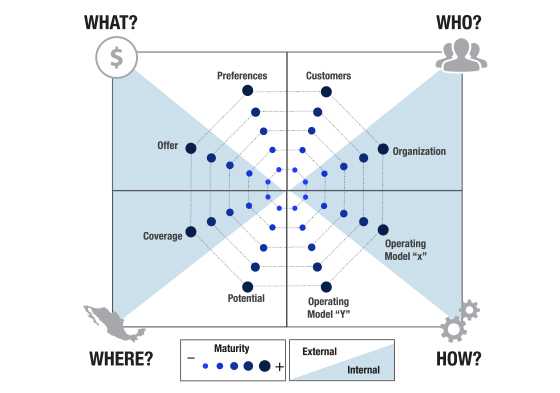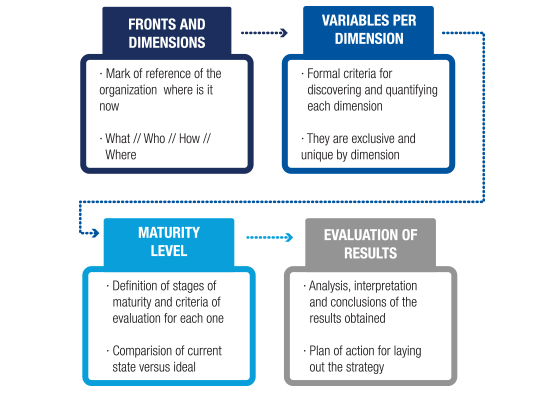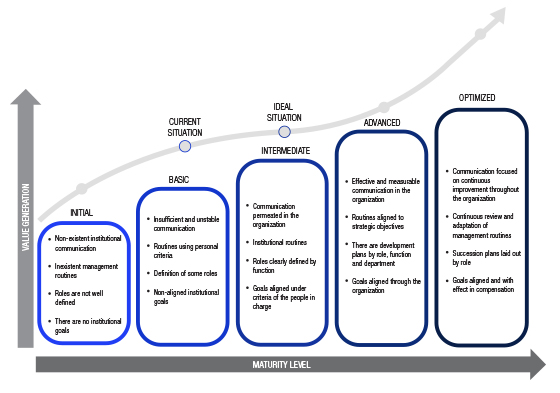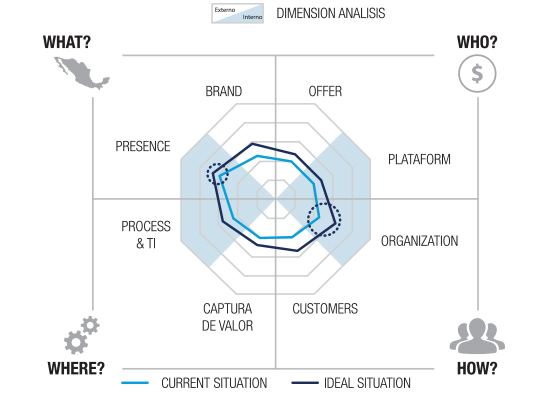How the Managing Director approaches growth opportunities over the foundation of capacities of the business to develop them effectively
THE CHALLENGE
The main task of the Managing Director is to lead the organization toward stable and sustained growth in a profitable manner. In order to do so, he must determine whether the path being traversed is the correct one or if new alternatives should be explored. When entering new growth paths, the organization faces certain business implications that, if ignored, may cause the initiatives to fail. The challenge for the MD lies in being able to select business opportunities that, in terms of effectiveness, are most adequate to achieve the growth goals that have been set.
WHERE TO START? – BUILD A REFERENTIAL FRAMEWORK
When determining what is the strategy that should guide the organization, the MD must have a general framework of understanding,that allows him to diagnose what Bls are available in the business to tackle growth opportunities. Said framework involves the following elements that enable a decision making process that focuses in meeting business goals:
- Evaluating the level of maturity in the organization
- Dimensioning the gap of the current situation vs. the new reality
- Prioritizing opportunities from the same business reference
- Articulating the strategy over a uniform understanding
When diagnosing the capacities of the organization, it is useful to use graphic tools that visually represent values corresponding to data with more than 2 dimensions. A radial graph (also known as spider and/or star graph) compares the analysis fronts and dimensions in different scenarios, for example, the current situation vs. the new reality (ideal situation).
To build the referential framework it is necessary to define these analysis fronts and dimensions that allow the organization to get to know itself, and its environment, to then define the skills that it will use to tackle growth opportunities.The fronts are presented in 4 major business questions:
- What?
- Who?
- How?
- Where?
These fronts respond to each other in terms of internal and external analysis dimensions to place the organization in a current level of maturity and to compare it with the level required given the business opportunity under review.
The internal and external analysis dimensions are defined with the following criteria for an integral diagnose of the company:
- What?
- Offer – Value proposal that is offered to the market.
- Preferences – client needs that the company intends to cover
- Who?
- Organization – position and structure of who serves the client
- Clients – identification and classification of who the clients are
- How?
- X Operational Model – how does the organization operates
- Y Operational Model – how does the main competitor operates
- Where?
- Coverage – geographies and/or channels where the business operates
- Potential – sites, media or clients where it generates value
These analysis fronts and dimensions, when evaluated, objectively and numerically place the company in a current situation which can then be compared with the ideal business position in terms of the capacities of the organization. The bigger the gap between the current situation and the new reality, the greater the complexity the company will face to effectively develop the business opportunity defined. The business impact of any strategy that is deployed will be only as big as the awareness that the organization has of its own level of maturity.
¿WHAT IS THE KEY TO SUCCESS? – DEFINING VARIABLES PER DIMENSION
To build the referential framework, it is fundamental to determine the variables that describe and quantify each dimension per analysis front. It is based on this definition that the capacities and the level of maturity of an organization are understood by decision makers and aligned with any growth strategy that is designed.
The variables to be determined vary depending on the industry, the business opportunity, the nature of the dimension and the analysis front, however, there are certain conditions that all variables must meet for the diagnosis to be adequate in any business situation/circumstance:
- Availability of the information
- Practicality of the evaluation
- Updating flexibility
- Readiness to adapt to the environment
Bearing these conditions in mind, the diagnosis becomes practical, reliable and easy to understand between the members of the Managing Team, because it allows them to articulate the strategy over the foundation of a uniform understanding.
Once the variables of each analysis dimension have been defined, it is necessary to establish what level of maturity means at every stage where the business opportunity will be evaluated from the current to the ideal situation of the business. Typically, the stages of maturity are related to the establishment of processes, practical improvements and business definitions that are a reference in the industry to which the company is related.
Below is a real case of the results obtained by a company when evaluating their current vs. their ideal situation in terms of the level of maturity to tackle growth opportunities.
The analysis front and dimension is related to a company in the service industry with the following elements:
Analysis Front – Who? Analysis Dimension (internal) – Organization
After completing the exercise, the result shows a graphical representation of the values of the current vs. the ideal situation of the company for the analysis fronts and dimensions. In this real life example, the bigger gap between the two situations is in the Organization. Having a referential framework allows the company to compare the analysis fronts/dimensions from the same business perspective, which facilitates focusing and making decisions regarding what strategy must be followed based on the growth opportunities to be defined.
The results of the diagnosis, has allowed different organizations to establish priorities in their strategic plan and to define plans for improvement in the dimensions with the greater gaps to capitalize business opportunities derived from the strategic plan.
As benefits for the company, the diagnosis of company skills generates the following value attributes to enable an ad-hoc strategy in the organization:
- Objectivity – Evaluating the level of maturity in the business
- Prioritization – identifying necessary gaps to close and/or minimize
- Focus – establishing clearer business guidelines
- Consensus – define business strengths and act on them
CONCLUSIONS
When determining the ideal strategy for the business, the General Director must lead the company through an exercise in reflection on the current and future skills the organization has to tackle the business opportunities that may be defined.
Having a practical and homogeneous referential framework to diagnose the skills of an organization facilitates the decision making process at the time of selecting the business opportunities that, in terms of effectiveness, are most adequate to achieve the growth goals that have been set.
This referential framework focuses on responding to 4 major business questions (what, who, how and where) in terms of certain analysis dimensions and variables to evaluate the level of maturity of the company. The bigger the gap between the current situation and the new reality, the greater the complexity the company will face to effectively develop the growth opportunity. The business impact of any strategy that is deployed will be only as big as the awareness that the organization has of its own level of maturity.



